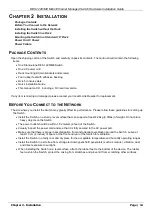
DES-1228/ME Metro Ethernet Managed Switch Hardware Installation Guide
Chapter 4 – Introduction to Switch Management
Page | 22
To create an administrator-level account for the Switch, follow these steps:
•
At the CLI login prompt, enter create account admin followed by the <user name> and press the Enter key.
•
The switch will then prompt the user for a password. Type the <password> used for the administrator account
being created and press the Enter key.
•
Again, the user will be prompted to enter the same password again to verify it. Type the same password and
press the Enter key.
•
Successful creation of the new administrator account will be verified by a Success message.
NOTE:
Passwords are case sensitive. User names and passwords can be up to 15 characters in
length.
The sample below illustrates a successful creation of a new administrator-level account with the user name
"newmanager".
DES-1228/ME:5#create account admin newmanager
Command: create account admin newmanager
Enter a case-sensitive new password: ********
Enter the new password again for confirmation: ********
Success.
DES-1228/ME:5#
Figure 4- 3. Create account command
NOTICE:
CLI configuration commands only modify the running configuration file and are not saved
when the Switch is rebooted. To save all your configuration changes in nonvolatile storage, you
must use the save command to copy the running configuration file to the startup configuration.
NOTICE:
In case of lost passwords or password corruption, please refer to the section titled
“Password Recovery Procedure” in Appendix B of the CLI Reference Guide which will guide you
through the steps necessary to resolve this issue.
SNMP
S
ETTINGS
Simple Network Management Protocol (SNMP) is an OSI Layer 7 (Application Layer) designed specifically for
managing and monitoring network devices. SNMP enables network management stations to read and modify the
settings of gateways, routers, switches, and other network devices. Use SNMP to configure system features for
proper operation, monitor performance and detect potential problems in the Switch, switch group or network.
Managed devices that support SNMP include software (referred to as an agent), which runs locally on the device. A
defined set of variables (managed objects) is maintained by the SNMP agent and used to manage the device.
These objects are defined in a Management Information Base (MIB), which provides a standard presentation of the
information controlled by the SNMP agent. SNMP defines both the format of the MIB specifications and the
protocol used to access this information over the network.
The Switch supports SNMP versions 1, 2c, and 3. You can specify which version of SNMP you want to use to
monitor and control the Switch. The three versions of SNMP vary in the level of security provided between the
management station and the network device.
In SNMP v.1 and v.2, user authentication is accomplished using 'community strings', which function like passwords.
The remote user SNMP application and the Switch SNMP must use the same community string. SNMP packets
from any station that has not been authenticated are ignored (dropped).






























